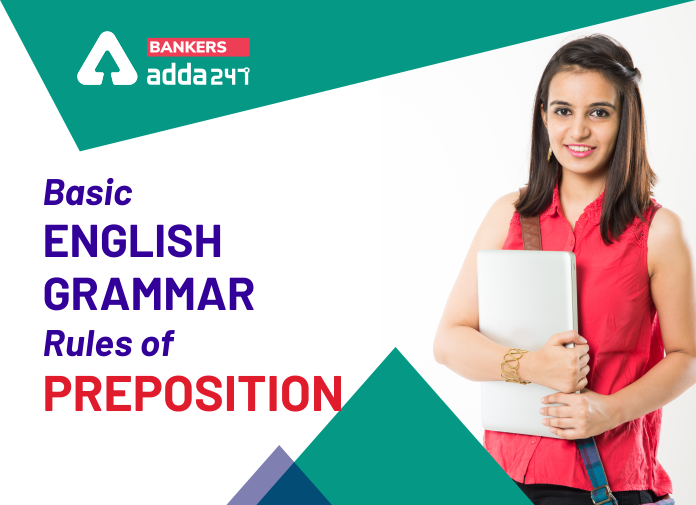If you are banking aspirants then you must be knowing the importance of English Language section. It can easily fetch you some very good marks if attempted carefully and with accuracy. Especially Grammar is very important section as it forms majority of the questions that are asked in the examination. In this article, we will be covering one of the most important topic of English grammar that is Prepositions.
Also read,
- Basics Rules of Noun
- Basic Rules of Verb
- Basic Rules of Subject-Verb Agreement
- Basic Rules of Conditionals
What is a preposition?
A preposition is a word used to connect nouns, pronouns, or phrases to other words within a sentence. They also tend to connect the people, objects, time and locations of a sentence. Prepositions are usually refers to short words, and they are normally placed directly in front of nouns. In some cases, we can also find prepositions in front of gerund verbs.
For our convenience we can also think about prepositions is as the words that help glue a sentence together. They work like this by expressing position and movement, possession, time and how an action is completed.
That is why, several of the most frequently used words in all of English, such as of, to, for, with, on and at, are prepositions.
One of the interesting to note is that prepositions are regarded as a ‘closed class’ of words in the English language which implies that, unlike verbs and nouns, no new words are added to this group over time.
Examples-
- She prefer to read in the library.
- She climbed up the ladder to get onto the roof.
- Please sign your name on the dotted line after you go through the contract.
- She swam across the pool.
- Take your Sister with you.
Types of Prepositions
There are mainly three types of prepositions that are time prepositions, place prepositions, and direction prepositions. Time prepositions are refers to words such as before, after, during, and until; place prepositions are refers to words indicating position, such as around, between, and against; and direction prepositions refers to indicative of direction, such as across, up, and down. Each type of preposition is important.
Also Read,
| How to Master Reading Comprehension to Score Maximum Marks? | Importance of Spoken English and How to Improve it? | SBI PO Prelims Study Plan 2020 |
Prepositions of Time
Time prepositions include: at, on, in, before and after. They are basically used to help indicate when something happened, happens or will happen. It can get a little confusing though, as there can be many different prepositions can be used.
Prepositions of time examples in the following sentences are in bold for easy identification.
For example:
- She was born on July 4th, 1982.
- She was born in 1982.
- She was born at exactly 2am.
- She was born two minutes before my twin brother.
- She was born after the Great War ended.
The above sentences makes it seem quite difficult, with five different prepositions used to indicate when something happened. However, we follow a set of guidelines that can help decide which preposition to use which is given below:
To indicate years, months, seasons, centuries and times of day, use the preposition in:
- I first met John in 1987.
- It’s always cold in January
- Easter falls in spring each year.
- The Second World War occurred in the 20th century.
- We eat breakfast in the morning.
To indicate days, dates and specific holiday days, use the preposition on.
- We go to school on Mondays, but not on Sunday
- Christmas is on December 25th.
- Buy me a present on my birthday.
To indicate times, indicators of exception and festivals, use the preposition at:
- Families often argue at Christmas time.
- I work faster at night.
- Her shift finished at 7pm.
Words Before and after should be much easier to understand than the other examples of prepositions of time. Both are used to explain when something happened, happens or will happen, but specifically in relation to another thing.
- Before I discovered this shop, I used to go straight home after work.
- We will not leave before 4pm.
- David comes before John in the line, but after Louise.
Other prepositions of time could include words like: During, about, around, until and throughout.
- The concert will be staged throughout the month of June.
- I learned how to skate during the holidays.
- She usually arrives around 3pm.
- It was about six in the morning when she made it to bed.
- The shop is open until midnight.
Also read,
- How to Increase Calculation Speed to Crack Bank Exams?
- English Grammar Rules that Can Get You Confused
Prepositions of Place
The most common prepositions to indicate time – on, at, in – are also the most common prepositions to indicate position of thing. However, the rules are a little clearer and makes it easy for us to decide their usage as place prepositions are a more rigid concept than time prepositions.
Prepositions of place examples in the following sentences are in bold for easy identification, take a look at them.
- The toy is on the table.
- The puppies are in the kennel.
- We can meet at the crossroads.
The guidelines are as follows:
On is used when we are referring to something with a surface:
- The painting hangs on the wall.
- The picture are on the page.
- You can order what is on the menu, which is on the table.
In is used when we are referring to something that is inside or within confined boundaries. This could be anything, even a country:
- Sonal is in France, visiting his aunt in the hospital.
- The wine is in the jar in the fridge.
- The boys play in the garden.
At is used when are referring to something at a specific point:
- The girls are at the entrance at the movie theater.
- She stood at the bus stop at the corner of Water and High streets.
- We will meet at the airport.
There are many other prepositions of place, such as under, over, inside, outside, above and below are used in English. They refer to rigid positions rather than abstract ones.
- The dog is under the table.
- Put the bottle over there.
- The phone is locked inside the car.
- We stepped outside the house.
- Major is ranked above captain.
Also Read,
| Upcoming Bank Exams 2020 | Government Jobs for Graduates 2020 | Consumer Price Index: Definition, Types, Measurement |
Prepositions of Movement
Words referring to Prepositions of movement are quite easy to understand as they are less abstract than prepositions of place and time. Essentially, they describe how something or someone moves from one place to another. The most commonly used preposition of movement is to, which basically serves to highlight that there is movement towards a specific destination.
Prepositions of movement examples:
- She has gone on vacation to France.
- He went to the bowling alley every Friday last summer.
- She will go to bed when I am tired.
- We will go to the zoo if they finish their errands.
Other prepositions of movement include: through, across, off, down and into. While they look similar, they have individual meanings that add context to the movement.
Across basically refers to moving from one side to another.
- Sierre traveled across America on his motorcycle.
- Roni and Judi are swimming across the lake.
Through indicates to moving directly inside something and out the other end.
- The bullet whichBen shot went through the window.
- The train passes through the tunnel.
Into indicates to entering or looking inside something.
- John went into the room.
- They stare into the darkness and found nothing.
Up, over, down, past and around refers to directions of movement:
- John went up the hill.
- Jack came tumbling down after.
- We will travel over rough terrain on our way to our house.
- The dogs runs around the track all morning.
- A train zoomed past a truck on the highway
Prepositions with Nouns
There are lots of nouns that carry specific prepositions to consolidate their meaning. These are known as dependent prepositions. Moreover, there are many possible combinations. Essentially, it’s case of familiarizing yourself with the different possibilities of nouns and their usage Examples:
- She displayed cruelty towards his dog.
- Hee had knowledge of physics.
Prepositions with Verbs
Prepositional verbs are the phrasal combinations of verbs and prepositions – are important parts of speech. The prepositions with verbs again act as links between the verb and noun or gerund, giving extra meaning to the sentence. The prepositions most commonly used with verbs are as follow: to, for, about, of, in, at and from.
Verb + to:
- She admitted to the charge.
- He go to Vancouver on vacation twice a year.
Verb + for:
- She must apologize for his actions.
- He searched for ages before we found the perfect apartment.
- He provide for my family by working two jobs.
Verb + with:
- she don’t agree with your claim.
- The lawyer said she will meet with your representatives.
- They began with a quick warm-up session.
Verb + of:
- He dream of a better life.
- Has she heard of Shakespeare?
- The bread consists of dough, raisins and a little bit honey.
Verb + in:
- Does Rocky believe in miracles?
- Farzi lives in New York.
- The car accident resulted in my being late to work.
Verb + at
- She arrived at our destination.
- She excels at singing.
- Will the baby smile at her father?
Verb + on:
- He should really concentrate on our studies now.
- Hella insisted on Brenda’s company.
- Mary experimented on some canvas.
Verb + from:
- Since turning 80, he suffers from lapses in concentration.
- Mom retired from the navy in the 1970s.
- Bob, please refrain from doing that.
Prepositions with Adjectives
Prepositions which can form phrases with adjectives to give further context to the action, emotion or thing the adjective is describing. Like verbs and nouns, adjectives which can be followed by: to, about, In, for, with, at and by.
- She is happily married to David.
- Ella is crazy about this movie.
- Mike is interested in politics.



 Weekly Current Affairs One Liners 23rd t...
Weekly Current Affairs One Liners 23rd t...
 CSIR CRRI Typing Test 2025 Date for JSA ...
CSIR CRRI Typing Test 2025 Date for JSA ...
 Can Final Year Students Apply for SBI PO...
Can Final Year Students Apply for SBI PO...


